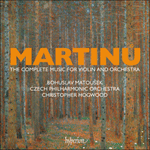
Welcome to Hyperion Records, a British classical label devoted to presenting high-quality recordings of music of all styles and from all periods from the twelfth century to the twenty-first.
Hyperion offers both CDs, and downloads in a number of formats. The site is also available in several languages.
Please use the dropdown buttons to set your preferred options, or use the checkbox to accept the defaults.

From this concerto grosso-style work Martinů adopted the typical alternation of solo and tutti, which fascinated him for a number of years. Typical for his works from the 1930s are the three-movement structure and the departure from sonata form with its individual themes, which are replaced here by a continuous fabric of delicate motivic elements. Emphasis is placed on orchestral colour. The freshness of the musical ideas and the virtuoso writing of the two solo violin parts make this eighteen-minute composition an extraordinary musical experience.
The premiere took place on 10 February 1938 in Yverdon (Switzerland) with Orchestre de la Suisse Romande under Ernest Ansermet. The solo parts were played by the brothers Georges and Victor Desarzens, who had commissioned the work and to whom it is dedicated. Victor later became a celebrated conductor; he founded the Orchestre de chambre in Lausanne and performed many orchestral pieces by Martinů in both Lausanne and Winterthur, his other place of work. Some autograph materials for the concerto were recently donated to the Martinů Foundation by Victor Desarzens’ daughter Martine, along with a very important and illuminating correspondence between her father and Bohuslav Martinů.
from notes by Aleš Březina © 2007
Pour cette œuvre en style de concerto grosso, Martinů adopta cette alternance solo/tutti qui le fascina si longtemps. Comme très souvent dans ses pièces des années 1930, la structure est en trois mouvements et les thèmes individuels de la forme sonate sont remplacés par un réseau continu de délicats éléments motiviques. L’accent est mis sur la couleur orchestrale. La fraîcheur des idées musicales et l’écriture virtuose des deux parties de violon solo font de cette pièce de dix-huit minutes une expérience musicale extraordinaire.
La première se déroula le 10 février 1938 à Yverdon (Suisse) avec l’Orchestre de la Suisse romande, sous la baguette d’Ernest Ansermet. Les parties solo furent assumées par les frères Georges et Victor Desarzens, commanditaires et dédicataires de l’œuvre. Victor deviendra un chef d’orchestre célèbre; fondateur de l’Orchestre de chambre de Lausanne, il exécuta maintes pièces orchestrales de Martinů à Lausanne et à Winterthur, son autre lieu de travail. Sa fille Martine a récemment fait don de documents autographes concernant ce concerto à la Fondation Martinů; elle a aussi donné une très importante, et fort éclairante, correspondance entre son père et Bohuslav Martinů.
extrait des notes rédigées par Aleš Březina © 2007
Français: Hypérion
Aus dem Concerto grosso übernahm Martinů den typischen Wechsel zwischen Solo und Tutti, der ihn eine Reihe von Jahren beschäftigen sollte. Viele seiner Werke aus den 1930er Jahren zeichnen sich durch eine dreisätzige Form und die Abwendung von der Sonatenform mit ihren individuellen Themen aus. Ersetzt wird die Sonatenform hier durch ein fortlaufendes Gewebe aus feingliedrigen motivischen Elementen. Die Betonung liegt auf Orchesterfarben. Die Frische der musikalischen Gedanken und die Virtuosität der zwei Soloviolinen in dieser 18-minütigen Komposition garantieren ein außergewöhnliches Musikerlebnis.
Die Uraufführung fand am 10. Februar 1938 in Yverdon (Schweiz) mit dem Orchestre de la Suisse Romande unter Ernest Ansermet statt. Die Solostimmen wurden von den Gebrüdern Georges und Victor Desarzens gespielt, die das Werk in Auftrag gegeben hatten und denen es auch gewidmet ist. Victor entwickelte sich später zu einem berühmten Dirigenten, gründete das Orchestre de chambre in Lausanne und führte sowohl in Lausanne als auch in Winterthur (seiner anderen Wirkungsstätte) viele Orchesterstücke Martinůs auf. Vor kurzem übergab Victor Desarzens’ Tochter Martine einige handschriftliche Quellen sowie eine sehr wichtige und erhellende Korrespondenz zwischen ihrem Vater und Bohuslav Martinů an die Martinů-Stiftung.
aus dem Begleittext von Aleš Březina © 2007
Deutsch: Elke Hockings
 Martinů: The complete music for violin and orchestra Martinů: The complete music for violin and orchestraA four-CD collection of this glorious music, now issued at super-budget price.» More |

